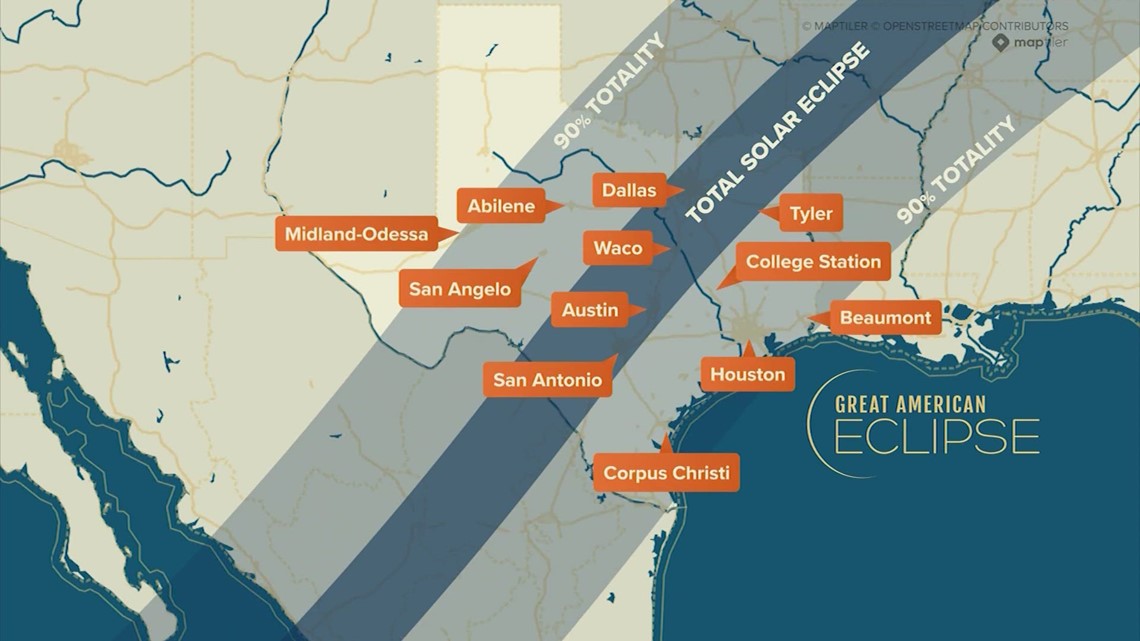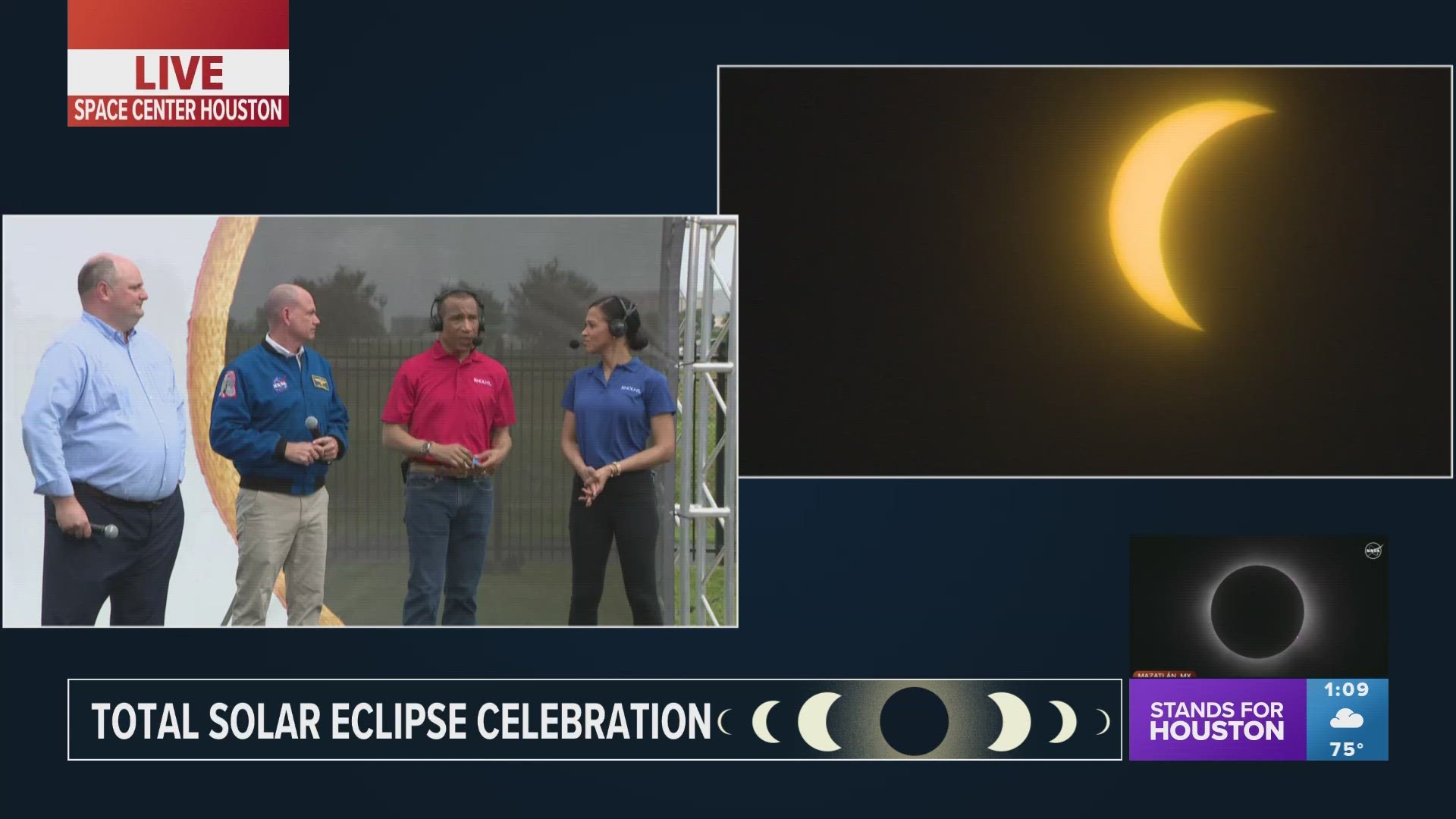HOUSTON — We’ve been telling you about it for months and now it's here. We’re talking about the Great American Eclipse on April 8. Totality will run across the United States, with Texas getting the first look.
If you're in Houston, you won’t see complete totality but will be pretty darn close. According to NASA, Houston will get 94.2 percent coverage. The partial eclipse begins in the Bayou City at 12:20 p.m. We’ll see the fullest coverage at 1:40 p.m. The partial eclipse then ends in Houston at 3:01 p.m.
If you're traveling to be in the path of Texas totality, below are the exact times the partial and total eclipse will start and end.
Eclipse in Eagle Pass
- Partial eclipse begins: 12:10 p.m.
- Totality begins: 1:27:33 p.m.
- Totality ends: 1:31:57 p.m.
- Partial eclipse ends 2:51 p.m.
Eclipse in Kerrville
- Partial eclipse begins: 12:14 p.m.
- Totality begins: 1:32:07 p.m.
- Totality ends: 1:36:31 p.m.
- Partial eclipse ends 2:55 p.m.
Eclipse in Austin
- Partial eclipse begins: 12:17 p.m.
- Totality begins: 1:35:57 p.m.
- Totality ends: 1:38:06 p.m.
- Partial eclipse ends 2:57 p.m.
Eclipse in Waco
- Partial eclipse begins: 12:20 p.m.
- Totality begins: 1:37:56 p.m.
- Totality ends: 1:42:12 p.m.
- Partial eclipse ends 3:00 p.m.
Eclipse in Dallas
- Partial eclipse begins: 12:23 p.m.
- Totality begins: 1:40:47 p.m.
- Totality ends: 1:44:38 p.m.
- Partial eclipse ends 3:02 p.m.
Eclipse in Clarksdale
- Partial eclipse begins: 12:27 p.m.
- Totality begins: 1:44:35 p.m.
- Totality ends: 1:48:56 p.m.
- Partial eclipse ends 3:06 p.m.


The times above are all from NASA's interactive map of the eclipse. If you want to see more cities across the country, check them out here.
Which Texas cities will spend the most time in totality during the eclipse?
If you're traveling to see the eclipse, there are great spots all across Texas to view it from. But where will you spend the most time in totality? KHOU 11's Shern-Min Chow breaks that down.
We have more information about Texas cities in totality here. As for the rest of the country, here's a list of locations outside of Texas and how long in minutes and seconds they'll be in totality.
- Idabel, Oklahoma - 4:18
- Broken Bow, Oklahoma - 4:16
- Atkins, Arkansas - 4:15
- Hot Springs, Arkansas - 3:36
- Little Rock, Arkansas - 2:21
- Cape Girardeau, Missouri - 4:05
- Jackson, Missouri - 4:10
- Poplar Bluff, Missouri - 4:08
- Wickliffe, Kentucky - 2:44
- Henderson, Kentucky - 2:30
- Vincennes, Indiana - 4:05
- Carbondale, Illinois - 4:09
- Evansville, Indiana - 3:02
- Indianapolis, Indiana - 3:48
- Bloomington, Indiana - 4:02
- Forest, Ohio - 3:56
- Upper Sandusky, Ohio - 3:55
- Norwalk, Ohio - 3:54
- Tiffin, Ohio - 3:52
- Findlay, Ohio - 3:44
- Dayton, Ohio - 2:42
- Cleveland, Ohio - 3:49
- Erie, Pennsylvania - 3:42
- Niagara Falls - 3:30
- Buffalo, New York - 3:45
- Orchard Park, New York - 3:43
- Rochester, New York - 3:41
- Watertown, New York - 3:38
- Burlington, Vermont - 3:14
- Dixville Notch, New Hampshire - 2:47
- Houlton, Maine - 3:20
What states will see the total solar eclipse in 2024?
The total solar eclipse's path will pass through 15 states — with Tennessee and Michigan just barely part of the totality.
Roughly 32 million people live inside the path of totality. The major U.S. cities that will have front-row seats to the celestial sensation include Dallas, Little Rock, Arkansas; Indianapolis, Cleveland and Buffalo, New York.
While those outside the path might not get to see complete darkness, many will still be able to witness the moon partially block the sun. The further away from the 115-mile stretch, the smaller the moon's bite out of the sun.
The eclipse will allow many to share in the “wonder of the universe without going very far,” said NASA’s eclipse program manager Kelly Korreck.
For more information on the specific cities that are in the path of totality, visit NASA's Where and When page.
How to see the solar eclipse 2024
The total solar eclipse will start as a partial eclipse and build its way up to totality.
Weather also plays a factor in how much of the solar eclipse you'll be able to see. Although, even with a cloudy day, the daytime darkness that comes with solar eclipses will still be noticeable, NASA said.
Viewers should always wear eclipse glasses during any solar eclipse, especially if there is no moment of totality.
How often do solar eclipse occur?
Solar eclipses of all kinds happen more frequently than one might think.
NASA breaks down the math to about 2,380 solar eclipses of all kinds every 1,000 years — or roughly 2-3 solar eclipses each year. For total solar eclipses, where the moon completely covers the sun, it works out to two eclipses every three years.
When was the last solar eclipse in the US?
The last time the U.S. had a total solar eclipse from coast to coast was on Aug. 21, 2017.
More than 215 million U.S. adults viewed the total solar eclipse, either in person or virtually, according to NASA.
When is the next solar eclipse after 2024?
North America won’t experience totality again until 2033, with Alaska getting sole dibs. Then that’s it until 2044, when totality will be confined to Western Canada, Montana and North Dakota.
There won’t be another U.S. eclipse spanning coast to coast until 2045. That one will stretch from Northern California all the way to Cape Canaveral, Florida.
What is a total solar eclipse?
On April 8, skies will darken to complete darkness for a few minutes as the moon completely blocks the face of the sun — known as total solar eclipse.
Such eclipses happen when the moon passes between the sun and the earth, casting a shadow on earth that will fully block the sun's light. Those located in the center of the moon's shadow when it hits earth will experience full totality, according to NASA.
Skies will darken as if it were dusk and temperatures will cool as a result of this phenomenon.
During these moments of darkness, most people will be able to witness the sun's corona, or its outer atmosphere — usually covered by the bright face of the sun.
Unlike other eclipses, this will be the only type that will allow viewers to momentarily take off their eclipse glasses during a small window where the sun is completely covered by the moon, NASA says. Until totality hits, viewers should always use their eclipse glasses or other methods of viewing, such as a pinhole projector.
Total solar eclipse can even mess with wildlife's perception of time.
During totality, some nocturnal animals may wake up as they think its nighttime. For nonnocturnal animals, they might think it's bedtime.
However, its only in recent years that scientists have started to rigorously study the altered behaviors of wild, domestic and zoo animals during a full solar eclipse.

